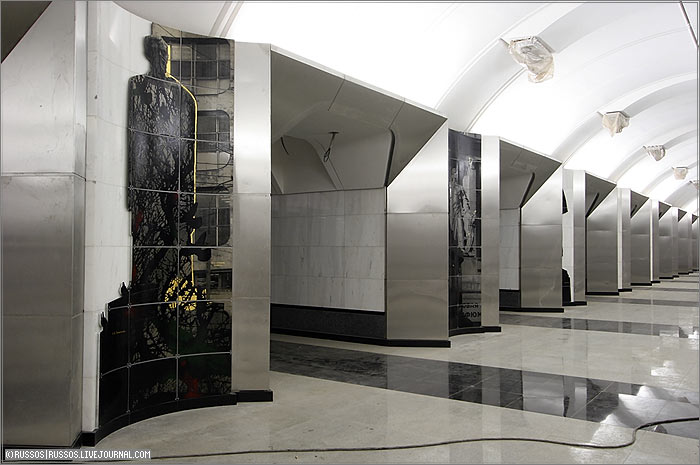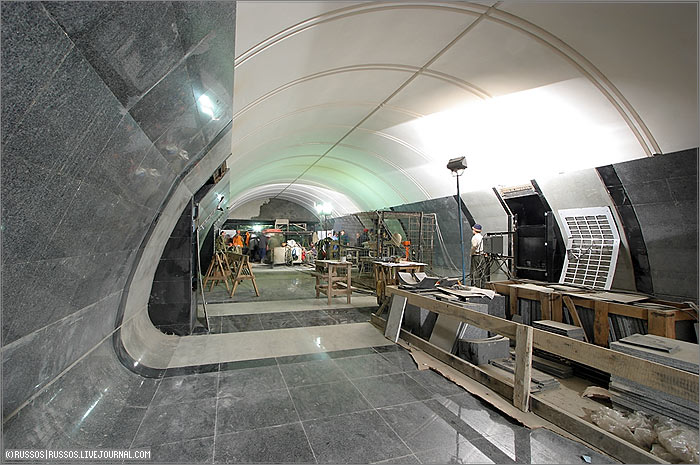|
|
Post by Dmitri on Nov 10, 2007 11:54:08 GMT
Why are these lines busier than the others? More people want to use them  . I think two main reasons are: 1) a phenomenon we call 'bedroom community' - huge clusters of blocks of flats ( like this) where only very limited number of jobs exist, so most of their population has to go elsewhere; 2) loss of jobs in the suburbs mean that more people commute to Moscow to get a job. Both items quite nicely coincide in the southeastern terminus of the 'purple' line ('Vykhino') which holds an infamous record of patronage - 170 000+ passengers daily (on working days). Something similar happens on the opposite end of the line ('Tushinskaya' station), however on a smaller scale - only 110 000+ passengers daily. |
|
|
|
Post by Dmitri on Nov 10, 2007 12:06:07 GMT
Very interesting are there any pictures of the actual signals Cannot recall anyone immediately... I can try to make some photos if anyone is interested. Take a look at this one and that one. Floodgates serve two purposes - civil defense and a protection from possible water break-in. (All photos from metro.molot.ru). |
|
|
|
Post by programmes1 on Nov 10, 2007 13:28:44 GMT
Dmitri many thanks the floodgate re the photo how are the gates closed? and do they have them across subways at stations, the TV programme I saw showed gates at the ends of platforms.
|
|
|
|
Post by edwin on Nov 10, 2007 21:27:11 GMT
Why are these lines busier than the others? More people want to use them  . I think two main reasons are: 1) a phenomenon we call 'bedroom community' - huge clusters of blocks of flats ( like this) where only very limited number of jobs exist, so most of their population has to go elsewhere; 2) loss of jobs in the suburbs mean that more people commute to Moscow to get a job. Both items quite nicely coincide in the southeastern terminus of the 'purple' line ('Vykhino') which holds an infamous record of patronage - 170 000+ passengers daily (on working days). Something similar happens on the opposite end of the line ('Tushinskaya' station), however on a smaller scale - only 110 000+ passengers daily. 170,000?! Isn't that higher than Victoria, King's Cross and Waterloo, which are all in central London!? |
|
|
|
Post by Dmitri on Nov 11, 2007 21:39:51 GMT
how are the gates closed? I've found 2 more photos here (5th and 6th big ones), and explanation below implies that there exist electrically and hydraulically-driven ones. The hydraulically-driven gate is on the pictures (that gate was retrofitted in the 1950s into the tunnel built in the 1930s, so space was limited, and electric drive is larger). TBH I don't know for sure. |
|
Deleted
Deleted Member
Posts: 0
|
Post by Deleted on Nov 11, 2007 22:38:24 GMT
Excellent pictures on those sites.  |
|
|
|
Post by programmes1 on Nov 12, 2007 17:54:25 GMT
Excellent photos give sme more questions which I will formulate.
|
|
|
|
Post by Dmitri on Dec 1, 2007 21:25:34 GMT
Mr. Russos has posted in his blog an animation of the floodgate being adjusted (mind the traffic - it is over 8 megabytes). Under the animated picture, there is a link to the bonus animation (~7 MB). Note: I call those monsters 'floodgates' as that term is readily understood by anyone. However, we call them unofficially 'hermetic shutters', and officially they are 'metal structures' (for that reason, signals guarding them carry 'MK' - 'МеталлоКонструкция' - designation). |
|
|
|
Post by edwin on Dec 2, 2007 23:31:10 GMT
What are the current trains going to be replaced with in the future? The "Rusich" or "Yauza" trains or something different?
And why are the doors so narrow? Me thinks they could improve dwell times with slightly larger doors...
|
|
|
|
Post by Dmitri on Dec 5, 2007 11:54:51 GMT
What are the current trains going to be replaced with in the future? The "Rusich" or "Yauza" trains or something different? Most likely "something different" - "Yauza" is no longer manufactured, "Rusich" has less doors and nonstandard car length. Not that narrow - ca. 1.3 m. Maybe  . |
|
|
|
Post by edwin on Dec 6, 2007 17:09:31 GMT
1.3m? That's not so bad I guess, perhaps they just look smaller because the trains are so large compared to what i'm used to!
|
|
|
|
Post by ilya on Dec 23, 2007 9:05:39 GMT
Hello everybody! Sorry to post so rarely, I'm having my exams in the University, so there's not much time to surf the net. This New Year our metro will bring two beautiful presents - two stations - 'Sretenski Boulevard' and 'Strogino'. 1) 'Sretenski Boulevard' station: (Photos by Mr.Russos russos.livejournal.com ) Platform:  Interchange to 'Chistiye Prudii' station  By the way, the station won't get its own exit - passengers will have to interchange to 'Chistye Prudii' or 'Turgenevskaya' first. _________ 2) 'Strogino' station. The extension of the blue line from 'Krilatskoe' station to the north. The tunnel between stations will be approximately 6,5 kilometres (!) lentgth and there will be two ghost stations between 'Krilatskoe' and 'Strogino' built for emergency exit - 'Tonnelnaya' (never to be opened, was built only two-car length) and 'Troitse-Likovo' station (to be opened 'round 2015 if there appear any apartments near it). Photos by The Official Moscow Metro Website mosmetro.ruThe station itself:  The map of the extension and future plans: (NB: Tonnelnaya station is where "Точка "D"" (point 'D') is written). There will be some more stations after 'Strogino' - Myakininskaya, Volokolamskaya, Mitino (with Mitino train depot) and Rojdestveno  |
|



